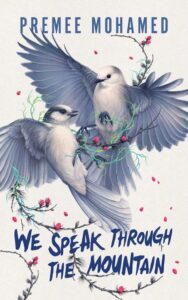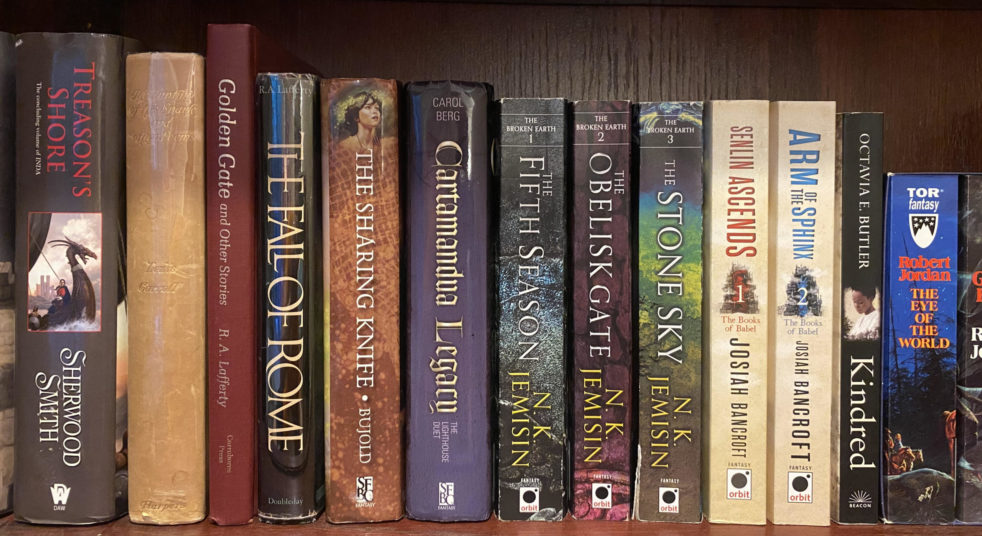

I’d missed The Annual Migration of Clouds when it came out, but after really enjoying Premee Mohamed’s The Butcher of the Forest and seeing the 2024 release of Clouds sequel We Speak Through the Mountain, I thought it was worth circling back and reading the pair together.
We Speak Through the Mountain is a direct sequel to The Annual Migration of Clouds, but both novellas are similarly structured, exploring different elements of post-apocalyptic society. Both are set in Alberta, following climate disaster that has killed off most of the forests and isolated technology to small, privileged enclaves, leaving everyone else scrambling for survival in the ruins of the old world. What’s more, a hereditary, semi-sentient parasite lives in the bodies of many survivors, bending their actions to its will.
In this environment are a pair of novellas about leaving. In the first, the lead is given a rare opportunity to study in one of those privileged enclaves, but she’s loathe to abandon a tight-knit community that needs all the hands they can get. In the second, it’s instead about leaving the enclave and trying to return some of their riches to her home.
In both novellas, the narrative is structured more around making a decision than it is around any results of that decision. But in both cases, the lead’s mind is pretty well made up at the start, so there’s not a whole lot of narrative tension as far as what she will ultimately choose. Instead, the novellas stand and fall on their explorations of ordinary life in two very different post-apocalyptic contexts.
In The Annual Migration of Clouds, that life consists in attempts to survive a harsh environment, to live with a self-interested parasite that refuses to allow the lead to put herself in danger, and in interpersonal conflicts with friends and family. Mohamed’s prose is always good, so it’s no surprise that the setting is brought vividly to life, or that it manages some genuinely tense subplots—particularly a dangerous hunt in which the lead must deal with both the rebellion of her own body and the weaknesses of fellow hunters—but the story as a whole feels more like “a week in the life” than anything. The interactions between the lead and her mother are remarkably grounded and very human, as is the internal struggle surrounding her decision, but I spent most of the novella wanting some element I could sink deeper into. There’s not a lot here to really criticize, but a plot structure that generates so little uncertainty around the ultimate climax must be exceptional in its portrayal of the journey, whereas The Annual Migration of Clouds is merely good.
We Speak Through the Mountain handles different themes, but it’s structured similarly and left me with similar feelings as The Annual Migration of Clouds. In the sequel, the lead finds herself in a secret enclave of knowledge and resources and is forced to reckon both with the culture shock and with her response to a group prepared to feed, clothe, heal, and teach her that hadn’t lifted a finger for her community writ large. And again, the strength here is in the details, particularly in the transition from an extremely communal culture to an individualistic one that leaves the lead feeling a baffled outsider. But again, the plan to gather some information and then return home is in place from the beginning, and while there is some temptation to stay—and mechanisms to prevent unauthorized departure—the broad arc of the story is in line with the plan.
On the whole, both books in the series do a good job exploring the lead’s complicated feelings surrounding her environment—whether the tight-knit, hardscrabble post-apocalyptic commune or the privileged enclave hiding themselves from the world—with strong prose and glimpses into ordinary encounters in the life of the lead. But they’re both structured in a way that anchors the tension to a decision that’s almost nearly made in the front, which robs some dramatic tension, and neither is so incredible in the details that it obviates the need for tension in the broader arc. The result is a pair of quality reads that nevertheless had me wanting a little bit more.
Recommended if you like: exploration of post-apocalyptic cultures, “day in the life” stories.
Can I use it for Bingo? It’s hard mode for Small Press and has a POC Author. The second book fits Stranger in a Strange Land.
Overall rating: for both stories, 15 of Tar Vol’s 20. Four stars on Goodreads.
